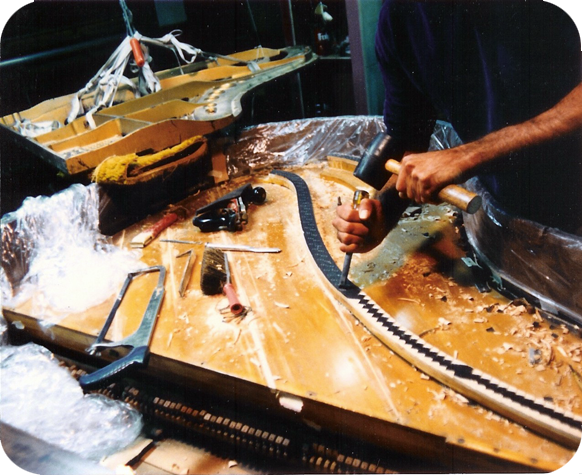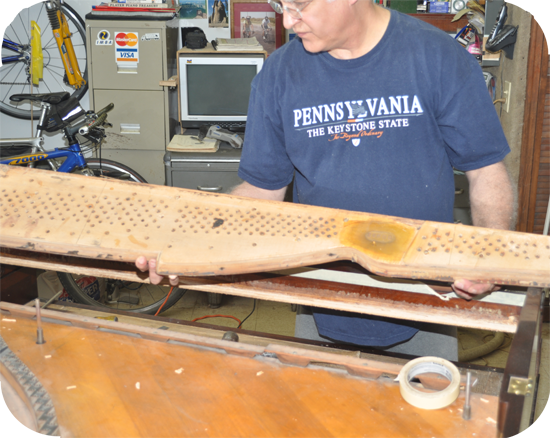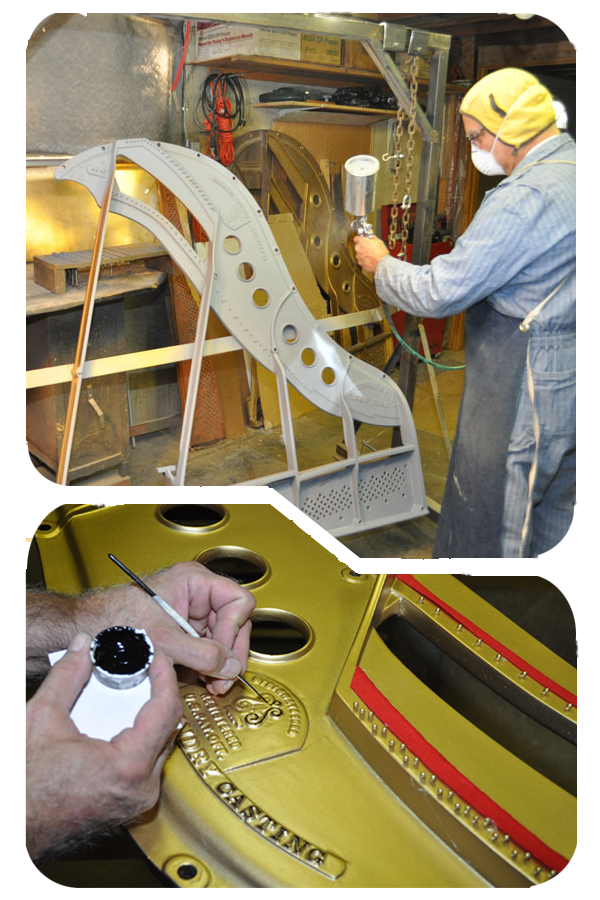
Complete Piano Service
816-587-1544
All piano repairs can be subdivided into three categories:
• Cabinet
• Harp
• Action
The most common cabinet repair involves refinishing.
Even though it is purely cosmetic, it is also the most
expensive. Cabinet shops typically charge over $1000
per foot. So that yard sale bargain spinet could wind
up costing another $3000 to remove the house paint.
The harp can be subdivided into four categories of
repair:
• Strings
• Pinblock
• Soundboard
• Plate

(Rebuilding a Bridge)
The strings are stretched over a cast iron plate and are in contact with the
soundboard via a wooden bridge. As a piano ages, the strings loose their tensile
strength much like an old spring fails to fully snap back. Even though there are
only 88 notes, a piano on average has about 230 strings with multiple strings
sounding one note. There is no repair for strings, they have to be replaced.
The pinblock is like the "Back Bone" of the piano. It is a tapered plank that is
about 5' long and is located behind / underneath the plate. The tuning pins,
which are attached to the strings, are driven into the plank and held in place by
friction. When the pinblock fails, the tuning pins become loose and the strings
will no longer have tension. There are 3 repair techniques for the pinblock:
• Apply a pin tightener solution to the tuning pins
• Replace original tuning pins with over sized pins
• Replace the pinblock

(Extracted Pinblock)
The soundboard is the speaker of the piano. A vibrating string displaces very little
air, and compression and rarefaction of air is what you hear as sound. To amplify
the sound (move more air), the string is attached to the soundboard via a bridge.
Now, instead of moving a tiny sliver of air from a string, a soundboard that is
5' wide and 3' to 7' long is vibrating and pumping out a huge column of air.
Changes in humidity cause the soundboard to expand and contract repeatedly. This
constant pushing and pulling eventually causes it to crack. Just like a blown stereo
speaker, a cracked soundboard produces a hollow rattling sound. A cracked board
can be repaired. The difficulty lies in trying to access both sides of the board
which can involve removing the strings and plate.
Like the cabinet, repairs to the plate are largely cosmetic. It involves stripping the
old finish and applying new metal flake lacquer. The procedure is often referred to
as regilding. If the plate has damage, i.e. cracked, the piano is a total loss. The cast
iron cannot be welded without warping.
The action is the machinery that drives the whole thing. A hammer accelerates
from 0 to 40 mph over a span of a couple of inches, slams into a string and re-
verses its direction with almost the same velocity. On average, the action is com-
prised of 19,000 component parts. With so many moving parts, there's a lot that
can go wrong.
To view these (and other) specific repairs feel free to view the Gallery where they
are presented in a slide show format. More items will be added as I continue to
build the pages.

(Installing New Hammers)

(Refinishing & Lettering a Plate)